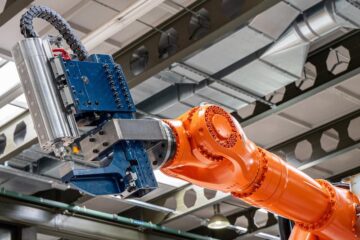Doing More with Less: New Technique Uses Fraction of Measurements to Efficiently Find Quantum Wave Functions

Just two years ago, with the advent of a technique called direct measurement, scientists discovered they could reliably determine a system’s wave function by “weakly” measuring one of its variables (e.g. position) and “strongly” measuring a complementary variable (momentum). Researchers at the University of Rochester have now taken this method one step forward by combining direct measurement with an efficient computational technique.
The new method, called compressive direct measurement, allowed the team to reconstruct a quantum state at 90 percent fidelity (a measure of accuracy) using only a quarter of the measurements required by previous methods.
“We have, for the first time, combined weak measurement and compressive sensing to demonstrate a revolutionary, fast method for measuring a high-dimensional quantum state,” said Mohammad Mirhosseini, a graduate student in the Quantum Photonics research group at the University of Rochester and lead author of a paper appearing today in Physical Review Letters.
The research team, which also included graduate students Omar Magaña-Loaiza and Seyed Mohammad Hashemi Rafsanjani, and Professor Robert Boyd, initially tested their method on a 192-dimensional state. Finding success with that large state, they then took on a massive, 19,200-dimensional state. Their efficient technique sped up the process 350-fold and took just 20 percent of the total measurements required by traditional direct measurement to reconstruct the state.
“To reproduce our result using a direct measurement alone would require more than one year of exposure time,” said Rafsanjani. “We did the experiment in less than 48 hours.”
While recent compressive sensing techniques have been used to measure sets of complementary variables like position and momentum, Mirhosseini explains that their method allows them to measure the full wave function.
Compression is widely used in the classical world of digital media, including recorded music, video, and pictures. The MP3s on your phone, for example, are audio files that have had bits of information squeezed out to make the file smaller at the cost of losing a small amount of audio quality along the way.
In digital cameras, the more pixels you can gather from a scene, the higher the image quality and the larger the file will be. But it turns out that most of those pixels don’t convey essential information that needs to be captured from the scene. Most of them can be reconstructed later. Compressive sensing works by randomly sampling portions from all over the scene, and using those patterns to fill in the missing information.
Similarly for quantum states, it is not necessary to measure every single dimension of a multidimensional state. It takes only a handful of measurements to get a high-quality image of a quantum system.
The method introduced by Mirhosseini et al. has important potential applications in the field of quantum information science. This research field strives to make use of fundamental quantum effects for diverse applications, including secure communication, teleportation of quantum states, and ideally to perform quantum computation. This latter process holds great promise as a method that can, in principle, lead to a drastic speed-up of certain types of computation. All of these applications require the use of complicated quantum states, and the new method described here offers an efficient means to characterize these states.
Research funding was provided by the Defense Advanced Research Projects Agency’s (DARPA) Information in a Photon (InPho) program, U.S. Defense Threat Reduction Agency (DTRA), National Science Foundation (NSF), El Consejo Nacional de Ciencia y Tecnología (CONACYT) and Canadian Excellence Research Chair (CERC).
Contact Information
Peter Iglinski
Senior Press Officer, Science & Public Media
peter.iglinski@rochester.edu
Phone: 585-273-4726
Mobile: 585-764-7002
Media Contact
More Information:
http://www.rochester.eduAll latest news from the category: Physics and Astronomy
This area deals with the fundamental laws and building blocks of nature and how they interact, the properties and the behavior of matter, and research into space and time and their structures.
innovations-report provides in-depth reports and articles on subjects such as astrophysics, laser technologies, nuclear, quantum, particle and solid-state physics, nanotechnologies, planetary research and findings (Mars, Venus) and developments related to the Hubble Telescope.
Newest articles

Mobility of the future, quantum technologies, space travel, transfer
The University of Stuttgart at Hannover Messe ’24. From sustainable mobility to quantum technologies and their potential: The University of Stuttgart will be showcasing exciting research projects, pioneering solutions, and…

Culinary pleasure meets innovative cutting-edge research
CeTI Cluster of Excellence at TU Dresden opens “robot kitchen”. April 15, 2024, the Cluster of Excellence Centre for Tactile Internet with Human-in-the-Loop (CeTI) at TUD Dresden University of Technology…

Bumblebees Don’t Care about Pesticide Cocktails
In their natural environment, wild bees are exposed to various pesticides that can have a potentially toxic effect. A study by the University of Würzburg has now shown that bumblebees…





















